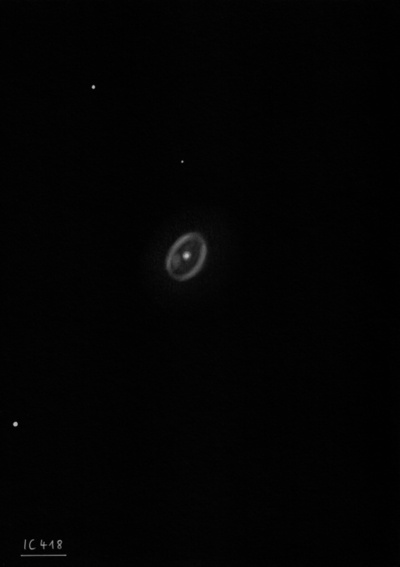
Williamina Fleming discovered IC 418 on 26 Mar 1891 based on a spectrum plate taken at Harvard College Observatory. In a letter communicated by Pickering in AN 3049, she mentioned the hydrogen spectrum [H-beta] was unusually large for a planetary. Pickering was attributed with the discovery in the NGC. W.W. Campbell, who credited Fleming with the discovery, made the first visual observation. In 1891 he reported "it is a beautiful object as seen in the 36-inch telescope [Lick], consisting of a 9th magnitude star surrounded by a circular disc of blue light nearly 15" in diameter."
Based on Crossley photographs, Curtis (1918) reported, "central star of mag 19, surrounded by a bright somewhat elliptical ring 14"x11" in outside diameter, and about 12"x10" along its central line; pa 163°." Walter Scott Houston may have made the first visual observation in 1945 using a 10" reflector.
A star is plotted at this position on the Uranometria 2000.0 Atlas because the BD catalogue included the central star.
200/250mm - 8" (2/5/81): nearly stellar at 100x, bright, appears as a mag 10 star with a small, faint bluish halo.
300/350mm - 13.1" (10/20/84): very bright, small, takes 350-410x well, bright central star, subtle shell structure.
400/500mm - 17.5" (2/22/03): at 100x, the bright 10.5 magnitude central star was centered in a 10" round halo with a definite rosy or raspberry tint at the outer edge of the halo, though the effect is fairly subtle. Using an H-beta filter, the central star is strongly dimmed but the halo is significantly enhanced, dramatically changing the view of this planetary. At 380x, no color was visible but the halo was a bit asymmetrical with a "softer" edge and possible double shell structure. The center was very slightly darker around the central star.
17.5" (12/30/99): at 82x the mag 10.5 central star was enveloped in a very small round halo which appeared to have a slight reddish tinge at its edge. This is a low-excitation PN and using a H-beta filter, the halo brightened and the central star faded, leaving a more noticeable disc. At 220x, the prominent central star was surrounded by a well-defined 10" halo that partially "blinked" on and off switching from averted to direct vision. At 280x, the small halo was possibly surrounded by an extremely faint envelope, but this could not be confirmed. 380x and 500x presented a superb view of the inner disc which appeared weakly annular.
17.5" (3/8/97): unusually bright mag 10.5 central star surrounded by a small high surface brightness halo. At 220x, this planetary has a distinct "blinking" effect; staring at central star partially washes out the halo and with averted the halo is more dominant. At 82x, an unusual rosy tinge is evident at the edge of the small halo, although the effect is fairly subdued. The seeing was not steady enough for high power viewing of the outer shell.
17.5" high surface brightness planetary, appears very bright at 481x. Contains a bright "fuzzy" central star with a bright inner portion surrounded by a second fainter shell slightly elongated N-S.
900/1200mm - 48" (2/18/12): at 488x, the sharply defined, vivid raspberry annulus appeared relatively thin and extended NNW-SSE, ~14"x12". The high contrast central dark hole was striking surrounding the bright central star. Surrounding the annulus is a faint outer halo, increasing the size to roughly 20".
48" (4/2/11): truly impressive view at 375x and 488x, which revealed a very high surface brightness, slightly elongated halo, ~14"x12", surrounding the very bright central star. I was surprised to see the planetary was clearly annular with a very bright, irregular rim that varied slightly in thickness and a fairly high contrast darker hole surrounding the central star. The ring's outer rim was a shocking, deep raspberry color. The color was more intense at 375x and slightly more saturated along one-half of the annulus.
Notes by Steve Gottlieb